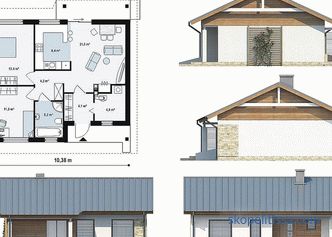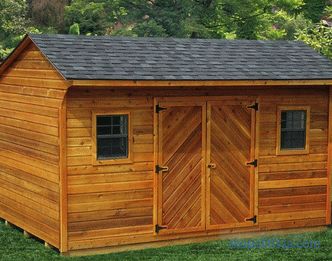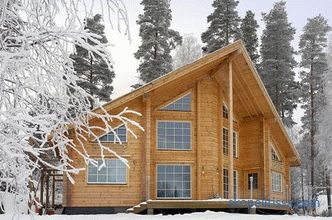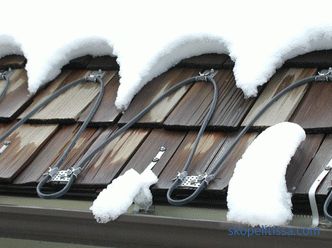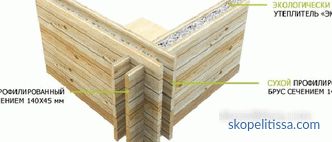Corrosion of metals, it is rust - the most dangerous enemy for the car. In this case, it is not atmospheric precipitation that is dangerous, but high humidity, which is damp, which is formed inside a closed space. Therefore, waterproofing the garage is given special attention. It doesn’t matter whether there is a basement or a viewing pit in the garage or not. Waterproofing work must be carried out necessarily. Therefore, in this article we will talk about what technologies today are used to form a waterproofing barrier, what materials they use.
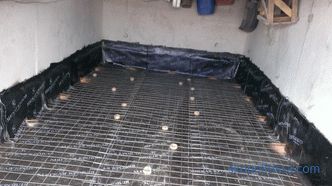
Types of Waterproofing
Let's start with this, or rather, sound types of waterproofing protection, which are now used in the construction of buildings and structures. These varieties are:
-
pasting ;
-
pasting ;
-
painting ;
-
sprayed ;
-
penetrating ;
-
injection .
For waterproofing garage buildings usually use one of the first three. These technologies use inexpensive materials, and the process itself is simple.
Pasting waterproofing
This is the application of rolled waterproofing materials to the protected surfaces. Previously used roofing material, which was laid on the hot bitumen in two layers. Today, bitumen-polymer films are increasingly being used instead of ruberoid.
The best option is laying on the outside of the foundation or flat roof covering. The advantages of this technology include the ability to apply to virtually any building materials: concrete, metal, wood, slate, asphalt concrete, the old waterproofing coating. But this material has its drawbacks:
-
you have to carefully prepare the surface surface ;
-
gluing temperature - not less than + 10С;
-
when applying the material the foundation or roof must be dry ;
-
it is necessary to control the process for careful gluing , especially for the joints of two rolls .
Wall coating waterproofing
This is applied to the protected structures liquid waterproofing materials. Previously, it was preheated bitumen, today it was replaced with cold application bitumen mastic. The coating is carried out using standard tools: rollers, a brush or a spray gun. And this is a big plus. You can add to the advantages the low price of the waterproofing material itself.
Now about the shortcomings, but we will not mention the heated bitumen, which passed its positions:
-
the treated surface should be clean and dry;
-
work is carried out only in dry and warm weather ;
-
some mastic compositions it is necessary to heat , and this is connected with open fire .
It is recommended to use a waterproofing waterproofing only in cases where the probability of leakage is low. For example, a low level of groundwater flow, storm sewage works effectively, blind areas are properly filled.
This technology is used less and less on roofs. Usually only in conjunction with other materials. For example, installation of a rolled soft roof, which is glued with bitumen mastic.
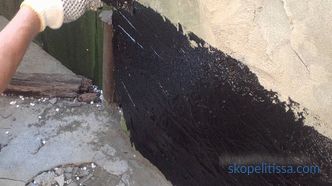
Painting
This is the use of special paints based on polymeric compositions. This technology is usually used for internal waterproofing of floors or walls of a building. In garage buildings, paints are rarely used, because the combination of the two previous options ensures one hundred percent protection against moisture penetration into the garage.
Sprayed
Probably, we must pay tribute to the sprayed variety, which is increasingly used for waterproofing flat roofs. The latter are most often found in garage buildings. For this purpose, a polymer-bitumen emulsion is used, which is called "liquid rubber" among specialists.
Mechanically emulsified under pressure using an air compressor. Therefore, the applied layer has a uniform thickness, and the speed of the work performed is very high.
But this waterproofing material has its drawbacks:
-
application is possible only at a temperature not less than + 5С;
-
applied material is afraid of punctures ;
-
the treated surface must be clean and dry ;
-
the high price of the material ;
-
the high cost of the services ;
-
for uneven planes, overrun of "liquid rubber" , which leads to overspending of funds;
-
this material for external waterproofing only.
Some masters make the mistake of using this waterproofing material to treat floors and basement walls. The fact is that the "liquid rubber" is not intended to ensure that water pressed on it from the treated surface. Under the action of the last waterproofing layer just peels off from the base. Its purpose is the treatment of roofs, where moisture in the form of precipitation presses from the outside, without touching the foundation.
Penetrating
And a few words about penetrating waterproofing, which is recommended to be used for processing basements and inspection pits. In fact, it is a cement-sand mortar, which contains special chemical active additives. The latter under the action of water penetrate into the thickness of, for example, the concrete foundation, blocking cracks, pores, capillaries, creating an impenetrable barrier in the form of crystals. Chemical additives, depending on the density of the concrete structure and the strength of the activity, can penetrate deeper up to 25 cm. The composition is applied as a plaster using spatulas and semi-graters.
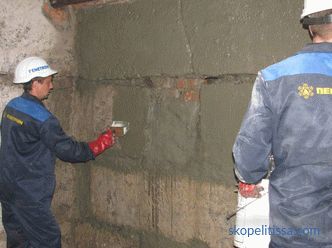
On our site you can familiarize yourself with the most popular projects of small forms - bathhouses, gazebos, garages - from construction companies represented at the exhibition "Low-Rise Country".
There are many advantages of this technology:
-
you can apply the solution from inside the basements without digging out the foundation of the garage outside ;
-
surfaces to be treated do not need to be dried ;
-
100% guarantee of protection concrete from water penetration;
-
self-healing of the composition , that is, as soon as water begins to penetrate through the appeared defects of the building structure, they immediately crystals ;
-
will start to grow unlimited lifetime ;
-
treated concrete loses its characteristics ;
-
ease of application;
-
manufacturers today offer formulations penetrating waterproofing , which can close gushing leaks .
And a few drawbacks:
-
penetrating waterproofing can be applied only on concrete structures , plastered or on screeds, in which concrete grade not below M150 ;
-
cannot be processed stone or brick laying, does not help;
-
application can be done only with a positive temperature - not less than + 5 ° С;
-
necessarily prepare the treated surface : embroider cracks, joints and other defects, clean the surface, degrease if a guide is carried out oizolyatsiya old concrete structures;
-
before applying the concrete it is necessary to moisten .
The video shows how to waterproof the basement with penetrating compounds:
Our site contains the most popular house manufacturers presented at the exhibition, which offer the service extension to existing houses and the construction of baths. Directly to communicate with representatives, you can visit the exhibition of houses "Low-rise Country".
If we talk about waterproofing the garage from the inside of the groundwater, the penetrating variety is the best option.
Type of waterproofing
There is also a separation of the method of protection from the negative effects of water and moisture, which is divided into two groups: horizontal and vertical.
The first is the laying of the waterproofing material over the horizontal elements of the garage. Usually it is a flat roof and the floor is built. As for the floor base, it is necessary to lay a layer of waterproofing above the zero mark by 20 cm. The task of the laid layer is to cut off the moisture that penetrates from below, that is, from the ground. Already on top of it pour a concrete screed, which forms the floor of the garage.
The second is basically the protection of the vertical surfaces of the basement and walls of the observation pit. Apply or glue the material from the outside to the full height, grabbing part of the wall of the garage building.
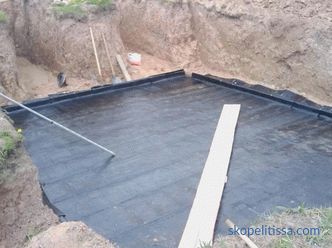
Waterproofing of garage structural elements
Let's consider what materials are better to waterproof constructive elements of construction, which technology is used for this.
It may be interesting! In the article on the following link read about waterproofing a flat roof.
Waterproofing the foundation
The best option is to conduct waterproofing processes from the outside. Therefore, even at the stage of forming the foundation, it is recommended to dig a trench wide, so that construction activities can be easily carried out in it. The minimum width of free space on the outer side of the foundation is 50 cm.
In general, the ideal solution for foundation structures is the combined method. That is, the walls of the structure are treated with bitumen mastic, on which they stick a rolled waterproofing material. Do it in stages. That is, put the mastic on a small area of the surface and immediately glue the cut to the size of the strip from the roll. The second strip is glued overlapped to the first one with an offset of up to 10 cm. It is important to overlap carefully so that the two bands do not peel off during operation.
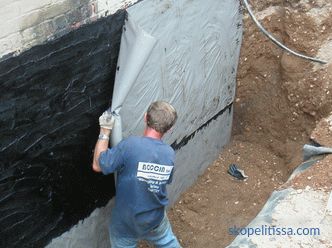
In this way, waterproof the foundation of the garage if it does not have a basement. If the ambulance is planned, it is recommended to carry out waterproofing from the inside. There is a sufficiently large number of applied technology and material. Ideal - penetrating technology. Budget option - coating with bitumen mastic, which is applied in two or three layers.
If the basement in the garage will be constructed, and the groundwater level is high, then it is necessary to take care of the protection not only of vertical planes. That is, under the foundation itself, a waterproofing layer is laid on the pillow. It can be rolled material in two or three layers, you can pour a thick layer of hot bitumen.
Be sure to waterproof the floor of the basement. To do this, roll material is laid on a pillow in at least two layers, arranging them across from each other. At the same time, waterproofing strips are necessarily removed to the basement walls at least 30 cm high. That is, a peculiar bath made of waterproofing material should form on the floor. After that, the walls of the basement are waterproofed using the same rolled material, which is glued to the bitumen mastic. But it is better, as mentioned above, to apply a penetrating method of protection.
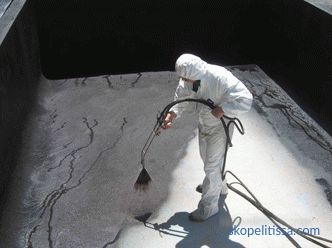
It may be interesting! In the article on read the following link about what to expect in the suburban real estate market in 2019 - step out of the window, up or down? The first is simpler and cheaper. In addition, with the help of a plastering solution, the walls are leveled in order to prepare for the further finishing of the room. Experts recommend penetrating solutions applied outside the walls of the garage, and inside use the usual leveling mixture.Roof installation
Everything is simple here. If the roof is flat, then it is formed by a concrete screed on which the roll soft roof is laid. Here are several options for the technologies used. Previously, hot bitumen and roofing felt were used for this. Today, bitumen-polymer roll materials based on fiberglass, which are placed on bitumen mastics, are used more often.
But recently, the method of hot application of roofing material has become very popular. This technology bears the name - the built-up roof. For this purpose, a special material of roll type is used, on the back side of which a layer of bitumen is applied. The latter should simply be heated with a gas burner and press the roll itself to the surface of the flat roof.
To help you understand what is being said, we suggest you watch the video showing how roofs are covered with this technology:
It may be interesting! In the article on the following link read about the cottage on the hillside in the pine forest near Flathead Lake, Montana.Conclusion on the topic
If you are careless about conducting waterproofing measures, it is likely that your car will start to rust soon. But not only. The garage itself will start to deteriorate and collapse. By the way, even modular garages assembled from metal were subjected to this.
